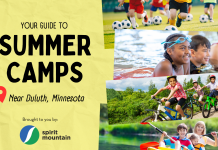 ’Tis the season for giving! Or in the overly-confident words of my toddler, ’tis the season of “What else did you bring me?” Yes he’s said that out loud and yes I actually cringed writing that. While my kids are just as sweet and innocent as any other juice-box toting kid on the playground they’re also super psyched to receive gifts, and I can’t blame them. I remember as a kid tearing into beautifully wrapped presents with the same unchecked enthusiasm; tossing the clothes and other boring gifts over my shoulder as I dove into the next box hoping for the latest Lisa Frank paraphernalia or a Cabbage Patch Kid. Even as an adult I find that in the excitement of celebrations it’s difficult to pause at teachable moments with my kids. But, in the chaos of this holiday season I’m dedicated to giving my family a different kind of gift: Gratitude.
’Tis the season for giving! Or in the overly-confident words of my toddler, ’tis the season of “What else did you bring me?” Yes he’s said that out loud and yes I actually cringed writing that. While my kids are just as sweet and innocent as any other juice-box toting kid on the playground they’re also super psyched to receive gifts, and I can’t blame them. I remember as a kid tearing into beautifully wrapped presents with the same unchecked enthusiasm; tossing the clothes and other boring gifts over my shoulder as I dove into the next box hoping for the latest Lisa Frank paraphernalia or a Cabbage Patch Kid. Even as an adult I find that in the excitement of celebrations it’s difficult to pause at teachable moments with my kids. But, in the chaos of this holiday season I’m dedicated to giving my family a different kind of gift: Gratitude.
Gratitude is so much more than just being polite about receiving something; research shows that habitually acknowledging gratitude can positively change the way we think. Our brains do this “fun” thing were they automatically tend to lean towards negativity unless we intentionally work to look at things from a positive perspective. With dedicated practice we can learn to change the way we think and react to situations and shift the perspective with which we view our life. By changing our own thoughts we can also show our children the practice and benefits of positive thinking.
To get started I encourage adults to keep a daily gratitude journal, or a daily log of things they’re grateful for in their life. It can be small things like, “I’m having a great hair day” to the bigger stuff like “I have running water and food in my fridge.” Gratitude journaling helps change the way we think after just thirty days of practice so keep at it and you might notice some changes in your own mindset. When it comes to gratitude for the whole family here are some things I’m hoping to stay mindful of this holiday season:
Say “No” More Often
It feels good to make our kids feel good. It can also feel pretty crappy when our kids feel crappy. I know I sometimes choose to say “yes” to the gummy worms before dinner because I don’t have the energy to say no but I also know there’s a part of me that wants my kid to be happy and I know that left unchecked that can turn into a real issue. The importance of saying ‘no’ is undeniable and is actually beneficial for our kids to experience. I know people often hear the word “boundaries” and they flinch at the idea of shutting out or saying ‘no’ to someone they love but boundaries get a bad rap. They exist to keep our relationships healthy, not hinder them, and in parenting boundaries help our kids to deal with disappointments in a safe, supportive environment where they can learn how to set their own boundaries as well.
Less is More
We work hard to support our families and most parents choose to show some of their love in the form of material items. However in the past few decades the consumerism around gift-giving has escalated which for many families means more presents on holidays. At my child’s last birthday he received many gifts from friends and family that he opened all at once on the day of his party. I watched some of those items go untouched and forgotten, upstaged by the ones he saw as more exciting. I have a hunch that had they been opened on a different day he would have been more excited or paid more attention to those gifts as well. If we narrow down our gifts and look at quality over quantity we may find both the giving and receiving aspect of gifts to be more fulfilling.
Model Gratitude
As parents we are the ultimate teachers to our kids and they so love to learn by example. Naming our gratitude out loud for our children to hear instills that behavior into their sponge-like brains. Practice saying genuine thank you’s to your kids, and your partner, and naming things around you that make you feel good about your life. This could also help spark conversations around privilege and that ‘yes we have to pay for that water’ type concepts that may not have come up otherwise.
Rose and a Thorn
Using mealtimes with our kids to create connection is a long-passed down family tradition. Using this time to intentionally connect with each other, empathize, and name gratitude can make this an even more beneficial bonding time for our families. Encourage each family member to share their rose, or positive moment of the day, and their thorn; a challenging part of their day, to instill empathy, emotion identification, and gratitude. You may be surprised about the things you learn from and about your kids.
Best of luck to you and your family on this gratitude journey, cheers!










